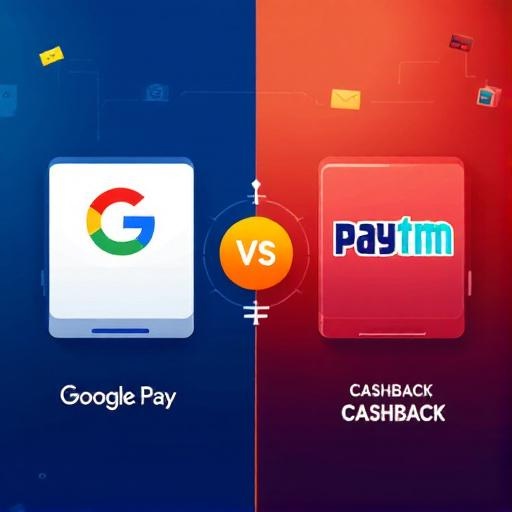In India, UPI (Unified Payments Interface) has revolutionized the way people conduct financial transactions. Among the top contenders in the Indian digital payments space are Google Pay and Paytm, two giants that have carved out their own niche. Both apps have millions of users, each offering a unique experience for sending money, paying bills, and handling various transactions. But when it comes to choosing between Google Pay vs Paytm, which one is the better option for you? This comprehensive guide will break down Google Pay vs Paytm based on UPI charges, transaction limits, and ease of use, helping you make an informed decision.
Google Pay vs Paytm: Overview of Both Platforms
Before diving into the specifics, let’s take a brief look at both platforms.
Google Pay: A Secure and Streamlined Experience
Google Pay has quickly become one of the most popular UPI payment apps in India, offering users a simple interface, security features, and a seamless integration with Google’s vast ecosystem. It allows users to make payments directly from their bank accounts and supports a wide variety of transactions, from bill payments to online shopping.
Paytm: The All-In-One Digital Wallet
Paytm started as a mobile recharge app and has since evolved into a full-fledged digital wallet service. The app offers UPI payments, mobile recharges, utility bill payments, shopping, and even access to financial services like insurance and loans. Paytm has established itself as one of the largest Indian fintech companies, catering to both individuals and merchants.
Google Pay vs Paytm: Key Features Comparison
When it comes to features, both Google Pay and Paytm are designed to provide convenience and flexibility. However, each platform has its own strengths and weaknesses.
1. Ease of Use: Google Pay vs Paytm Interface
Both platforms have user-friendly interfaces, but Google Pay’s minimalist design provides a smoother and more straightforward experience for people who prefer a clutter-free app. It integrates well with Google’s suite of products, making it convenient for Android users.
On the other hand, Paytm’s interface is slightly more complex due to the number of services offered. While this can be advantageous for users who want access to multiple features, new users might feel overwhelmed by the range of options.
2. UPI Integration: Google Pay vs Paytm UPI
Both apps are integrated with UPI, allowing users to send money directly from their bank accounts. However, Google Pay is often considered to have a more reliable and faster UPI transaction system, especially for peer-to-peer payments. Paytm, while also offering UPI payments, sometimes experiences slower transaction processing due to the added complexity of its app.
3. Google Pay vs Paytm for Merchants
Paytm stands out as the preferred platform for merchants, especially small and medium businesses. It offers a merchant account where businesses can accept payments, generate invoices, and manage their finances all from within the app. It also offers additional services like Paytm for Business, which gives merchants access to digital payment solutions like QR codes and payment links.
Google Pay, while offering merchant services through Google Pay for Business, doesn’t have as many in-depth features for businesses compared to Paytm. However, it’s still a solid option for smaller merchants and businesses looking for quick, low-cost payment solutions.
4. Transaction Limits: Google Pay vs Paytm
Transaction limits can vary based on the bank and UPI guidelines. Here’s a breakdown of the typical limits:
Google Pay UPI Transaction Limit: Google Pay follows the same transaction limits set by the NPCI (National Payments Corporation of India), which is typically ₹1 lakh per transaction. However, this limit may vary depending on your bank and account type.
Paytm UPI Transaction Limit: Similar to Google Pay, Paytm’s UPI limits align with NPCI guidelines, with a ₹1 lakh transaction limit per day. However, Paytm also imposes a daily limit of ₹25,000 for users who haven’t completed KYC (Know Your Customer) verification.
While both platforms offer a similar transaction limit, Paytm has more flexibility for users looking to complete bank-to-bank transfers or make peer-to-peer payments.
5. Cashback Offers and Rewards: Google Pay vs Paytm
Both platforms offer cashback and rewards as part of their customer retention strategies.
Google Pay Cashback: Google Pay offers cashback on specific transactions, especially for users who make regular payments or refer friends to the platform. It also has seasonal offers, such as discounts and cashback on bill payments and recharge services.
Paytm Cashback: Paytm frequently offers cashback on a variety of services, including mobile recharges, utility bill payments, and even online shopping. Paytm’s cashback offers tend to be more frequent and generous, particularly for users who regularly use the app for a wide range of services.
Google Pay vs Paytm: Security and Trustworthiness
Both platforms adhere to strict security standards to ensure secure mobile payments. Let’s compare their security features:
Google Pay Security: Google Pay leverages Google’s security infrastructure, including two-factor authentication, fingerprint authentication, and tokenization to keep transactions safe. As part of Google’s overall ecosystem, Google Pay is considered highly secure and is backed by Google’s reputation for privacy.
Paytm Security: Paytm also uses multi-layer encryption, two-factor authentication, and fraud detection algorithms to protect user data. While Paytm’s security features are robust, some users have raised concerns over potential data breaches due to its wide range of services.
In terms of authoritativeness and trustworthiness, Google Pay is often perceived as the more trustworthy platform due to Google’s established reputation in the tech industry. However, Paytm has been a leading force in India’s fintech ecosystem, making it highly trusted in its own right.
FAQs: Google Pay vs Paytm
1. Which is better: Google Pay or Paytm for UPI payments?
Both platforms offer similar UPI payment services, but Google Pay is often considered faster and more reliable for peer-to-peer payments, while Paytm provides a more comprehensive set of features, including merchant services.
2. What are the Google Pay vs Paytm UPI transaction limits?
Both apps follow the NPCI guidelines, with a typical transaction limit of ₹1 lakh per day. Paytm has lower limits for non-KYC users.
3. Which app offers better cashback: Google Pay or Paytm?
Paytm typically offers more frequent and generous cashback, particularly on services like mobile recharge and utility bill payments.
4. Is Google Pay secure?
Yes, Google Pay uses two-factor authentication, fingerprint verification, and tokenization to secure transactions.
5. Can I use Paytm for online shopping?
Yes, Paytm allows you to shop on its platform, offering a wide range of products and discounts on various goods and services.
6. Which app is more suitable for merchants: Google Pay or Paytm?
Paytm is generally more suitable for merchants due to its extensive payment solutions, including QR codes, payment links, and business-specific features.
7. Can I use Google Pay for bill payments?
Yes, Google Pay supports a wide range of bill payments, including electricity, water, and mobile bills.
Conclusion: Google Pay vs Paytm
Choosing between Google Pay vs Paytm ultimately comes down to your personal preferences and needs. If you’re looking for a simple, fast, and secure UPI payment app, Google Pay is the way to go. However, if you want a more comprehensive digital wallet with cashback offers, merchant services, and a wide range of features, Paytm is a solid choice.
Both apps are highly effective for UPI transactions, but each has its strengths. Consider what features matter most to you, whether it’s ease of use, transaction limits, cashback offers, or merchant tools. Either way, you’ll be making a good choice with either of these trusted online money transfer apps in India.








Comments (0)